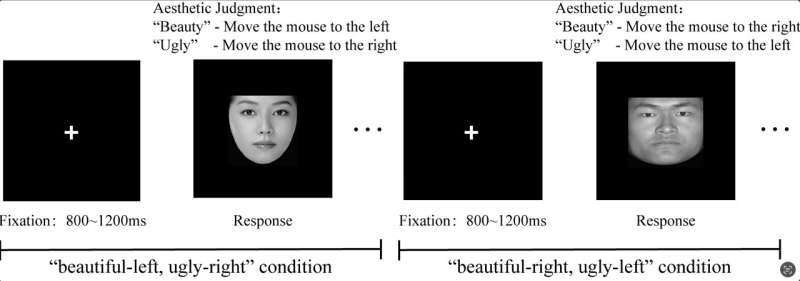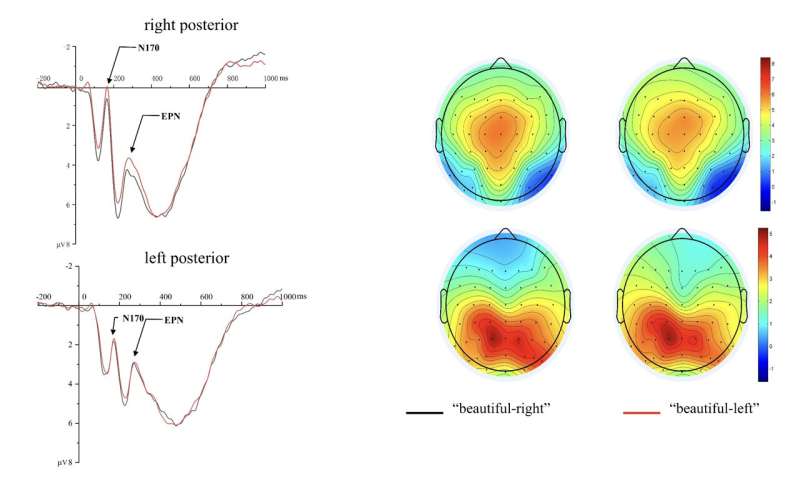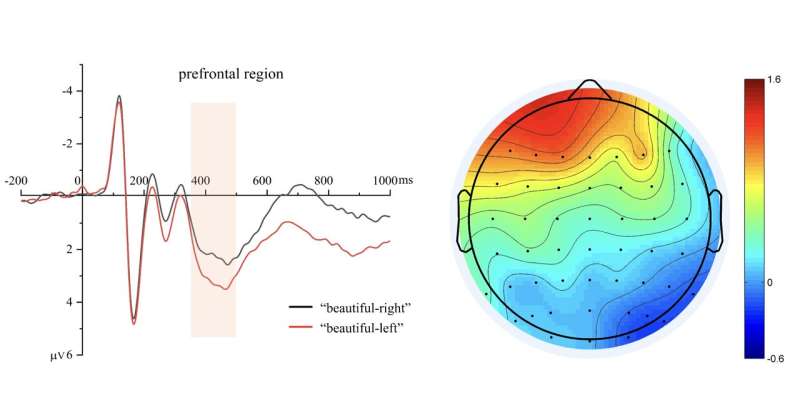January 26, 2024 feature
This article has been reviewed according to Science X's editorial process and policies. Editors have highlighted the following attributes while ensuring the content's credibility:
fact-checked
trusted source
proofread
Exploring the link between aesthetic judgments and 'screen swiping' hand movements

Humans commonly evaluate the beauty of other humans, as well as objects, places, natural landscapes, and even animals. The innate human tendency to make aesthetic judgments has been the topic of numerous psychological studies, yet its neural and cognitive underpinnings are not yet fully understood.
Linghe Li and Hanlin Wang, two researchers at Hebei Normal University recently carried out a study exploring the symbolic relationship between aesthetic judgments and horizontal hand movements, such as those that users perform when browsing through other people's profiles on dating apps. Their paper, published in Neuroscience Letters, gathered new insight about the cognitive processes that could underly human subjective evaluations of beauty.
"Our research is inspired by popular social applications that emerged in recent years, such as Tinder and Tantan," Li, lead investigator for the study, told Medical Xpress. "These apps use left or right swiping on smartphone devices to let users choose whether they want to take the next step in contacting, communicating and getting to know a person represented in a photo. We wanted to know why such an interface was chosen and whether there is a metaphorical link between horizontal hand movements and aesthetic judgment."
Many dating apps available today, including the renowned application Tinder, work by allowing users to select or discard potential dates by swiping left or right on their smartphones. In these apps, swiping right on a user's profile essentially means that one finds the person in the image physically attractive or beautiful, while swiping left means that they are not attracted to this person.

Li and Wang tried to determine whether these directional hand movements were in some way implicitly associated to evaluations of beauty. Their experimental methods build on a task called the implicit association test (IAT), which has often been used in psychology studies to assess the automatic, potentially biased associations that humans can unconsciously establish in their minds.
"Drawing on the logic of the IAT, we designed two joint categorical response tasks, 'Judge beauty—move the mouse to the left, judge ugliness—move the mouse to the right' and 'Judge beauty—move the mouse to the right, judge ugliness—move the mouse to the left,'" Li explained. "We found that 'Judge beauty—move the mouse to the left' was more consistent with the action response tendency in aesthetic judgment."
The researchers asked a group of participants to browse through pictures and evaluate the aesthetic beauty of the people represented in them by swiping left or right on their device. Notably, they performed two different experimental trials where the instructions changed slightly, as the meaning of left or right swiping motions changed (i.e., in one trial swiping left meant "beautiful" and right "unattractive," and vice versa in the second trial).
Li and Wang measured the time it took for their participants to respond to images (swiping left or right) during both trials. They also measured the brain responses that followed their aesthetic judgments of images, using an electroencephalogram (EEG), a widely used technology that records brain activity using small sensors attached on a study participant's scalp.

"By comparing the differences in reaction times and event-related potential components of the judgments between the two conditions, we found that 'judging beauty—move left' was more consistent with the tendency of action responses in aesthetic judgments," Li said.
"Combining the behavioral and event-related potentials (ERPs) results, the present study demonstrated a metaphorical association between horizontal hand actions and aesthetic judgments. It suggested that horizontal hand actions can affect the speed of aesthetic judgments by influencing processing fluency, emotional arousal level, categorization motivation, and attentional resources."
Essentially, the researchers found that when people were asked to swipe left to express that they found a person beautiful, they did so faster than when they were instructed to express their positive evaluations by swiping right. This suggests that directional hand movements are to some extent cognitively and implicitly associated with people's evaluation of beauty.
This recent study offers an interesting new perspective on the implicit links that the human mind might make between specific hand movements and aesthetic judgments, which could be in some way connected to the use of modern dating platforms or may have played a part in their development. The findings gathered by Li and Wang could soon inspire other studies investigating these unconscious associations more in depth.
"In the future, we would like to further explore whether this tendency of 'beauty to the left' action response is due to the 'approach-avoidance tendency,'" Li added. "In addition, we would like to find out whether spatial left/right affects this metaphorical connection."
More information: Linghe Li et al, Embracing beauty through leftward movements: An ERP study on metaphorical association between hand actions and aesthetic judgments, Neuroscience Letters (2024). DOI: 10.1016/j.neulet.2024.137627
© 2024 Science X Network



















